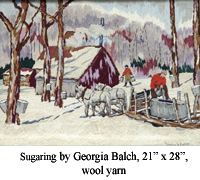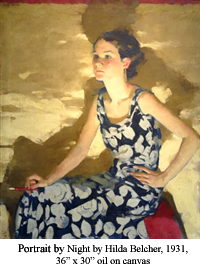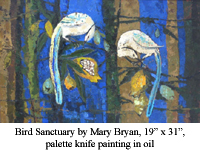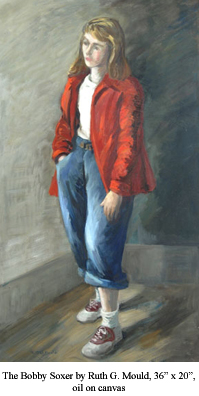
A Beautiful Legacy of Art by Our Vermont MastersBy Heather K. Michon
Martha Wood Belcher, Hilda Belcher, Georgia Balch, Ruth Mould, Mary Taylor Bryan - their names may be unknown to many Vermonters, but they left us an extraordinary legacy of art. The Mary Taylor Bryan Memorial Gallery in Jeffersonville is showcasing a portion of that legacy in the new exhibition, "Masters of Vermont." The show, presented in cooperation with the Vermont chapter of the National Museum of Women and the Arts and Vermont Woman, opened on April 15 and runs to June 17. Bryan Gallery's Executive Director Mickey Myers says that the exhibition grew out of a planned retrospective of Ruth Mould's work that she inherited from her predecessor when she took the position last fall. Myers also wanted to find a new angle on Mary Taylor Bryan. "I started to think how these women's legacies live on largely through the efforts of their families, and what could the Bryan do to strengthen the legacies," she says. This led naturally to the addition of other artists. Hilda Belcher was well known in her lifetime, and researching her background led to the inclusion of her mother, Martha Wood Belcher, who was a respected landscape artist in the late 19th century. Georgia Balch was a talented local artist in the Jeffersonville area. Each artist is represented by at least 15 paintings, supplemented by photos and other mementos. Some items will be available for sale. The gallery already had full collections of both Bryan and Mould's work. Balch and Belcher descendents contributed artwork and family stories for their relatives.
The lives of these artists, taken together, spanned 137 years, and their styles varied in medium, technique, and perspective. An examination of both their life stories and their creative output "clearly gives evidence of women who were masters of their lives, masters of their circumstances and masters of their art," says Myers. Martha Wood Belcher was born in Birmingham, England in 1844 and emigrated to Schenectady, New York with her parents and siblings in the decade before the Civil War. Her brother died in the war and her father died of illness not long after, leaving Martha, her mother, and two sisters to fend for themselves. They took in washing and sewing to pay the bills. Belcher, then in her early twenties, generated additional income through the sale of her landscape paintings, and through this sideline gained an admirer and patron. Major Brooks "underwrote Martha's study of art at the Cooper Union in New York City," Myers explains, "and a two-year tour of Europe, during which she studied in Dresden and Munich." She moved to Vermont to take a position teaching art at Ripley College in Poultney, and later designed and built her own home on Main Street in Pittsford, complete with a large, airy studio for her work. She brought her mother and sisters to live with her, and married a local businessman named Stephen Patterson Belcher in 1880. Their daughter Hilda was born in Pittsford in 1881 and spent her early childhood there. As head of the Ecclesiastical and Domestic Stained Glass Works, Stephen Belcher moved the family to Newark, New Jersey by the time Hilda was a teenager. After her graduation from high school in 1900, Hilda began her study at the New York School of Art, where she found a mentor in artist and teacher Robert Henri.
After graduation in 1904, Hilda Belcher stayed in New York, selling illustrations and cartoons to many prominent magazines of the time and designing stained glass windows for her father's company. It was during this period that she changed her medium from oils to watercolors. "I'd never studied watercolor in school, probably that's why, having to find my own way in it, I have enjoyed it more," she said in the 1940s. Once she transitioned to watercolors, she began to win critical acclaim. In 1908, she won the prestigious Strathmore Prize. "Her success in capturing the coveted honor fairly took away the breath of the 692 men competitors, who saw themselves obliged to take second place to the young Vermont student," said The New York Times. For Martha Belcher, too, the early 1900s was a time of transition. Her husband died in 1906, and around that time she also lost her mother and both sisters. In 1910, she was surprised to inherit a substantial sum of money from a relative in England, allowing her to live comfortably for the remainder of her life. She and Hilda used some of the money to travel across Europe in 1913-14. Martha died in 1930. Hilda Belcher never married and remained close to her family throughout her life. Ill health eventually brought her back to the comfort of the family home in Pittsford, where she lived until her death in 1963. Art was a constant in both women's lives until the end. Myers learned from a descendent that Martha would paint on virtually any surface, and that most of Hilda's later work focused on relatives, and even the family cats.
Like Martha Belcher, Georgia Balch entered the art world through a combination of passion and necessity. Born in Frelighsburg, Quebec in 1888, in her youth she moved to Johnson, Vermont, where her parents owned and operated a hotel. In 1914, she married the town's most eligible bachelor, Chester Arthur Stearns. As a wedding gift, her new in-laws built them a beautiful new home on what is today Route 100C. Chester Stearns died in the influenza epidemic of 1918-19, leaving Georgia a widow at 30. Rather than wallow in grief, she decided to devote herself to her art, packing up her baby daughter Joyce and traveling to Kansas City to attend the Art Institute. Upon her return to Vermont, she married a man named Roman Balch and settled back into the home and studio in Johnson. Comparatively little is known about Balch's life and work, although Myers is getting to know her well: she is the current owner of Balch's house and works out of her former studio. Many of Balch's works were painted outdoors, however. The Jeffersonville-Johnson area has been popular with many such plein air landscape artists for decades. Myers is often amused by the sight of local painters "in their duck boots and slicks, bundled against the snow and winter weather, dedicated to their process, regardless of the weather." Balch eventually put out a sign in front of her house announcing "Paintings of Vermont by Georgia Balch." For the next 50 years, tourists were invited into her studio to view and purchase her landscapes, and, says Myers, "to taste whatever she was cooking that day, as she often invited them for a meal." Later in life, when crippling arthritis made it too difficult to paint, "she began painting with yarn." She died in 1981 at the age of 92. Balch was good friends with an artist who grew up just down the road in Morrisville: Ruth Green Mould. Born in 1894, she studied with a local artist named Lilian Fish as a child, and later attended the Art Institute of St Paul, Minnesota. Back in Vermont, she taught art at the Johnson Normal School and for the Montpelier school system. In 1915, she married a mining engineer and geologist named Willis Mould. During his career, they lived in a number of towns, including Monkton, Williamstown, Barre, Morristown, plus Keysville and Elizabethtown, New York. No matter where they lived, Willis made sure Ruth had a "proper" spot for her easel. Mould was a talented portraitist, and her oil painting of Edna Beard, the first female member of the Vermont House and Senate, still hangs in the State House. She was one of two artists to represent Vermont at the 1939 World's Fair in New York. Although she never sought the limelight, her work was shown in New York, Boston, and Vermont. She was also an early student of the revival in American decorative arts such as stenciling, and published a book on painting on furniture in 1953. Mary Taylor Bryan took a long and winding road to Vermont. Born in Carlsbad, New Mexico in 1906, she grew up in Connecticut and California, where she showed an early talent for art, particularly sculpture. Throughout her long career, she explored a wide variety of different mediums, including oils, watercolors, tempura, pottery, enamel work, lacquer, decoupage and fiber arts. She married painter Alden Bryan in 1936 and moved to Gloucester, Massachusetts, where they owned and operated the Bryan Gallery on nearby Rocky Neck for 30 years. In 1941, they settled at Windridge Farm in Jeffersonville. Bryan painted every day, usually sitting down at her easel before her first cup of coffee. After her death in 1978, Alden Bryan opened the Jeffersonville gallery in her honor. Now in its 23rd year, this non-profit center remains dedicated to showcasing the area's finest landscape painting. In February, a couple of days before she was to meet with the Belcher family and make her final selection for the exhibition, Myers took a fall down the steps of her home and broke her pelvis. She put together much of the show from a hospital bed installed in her own bedroom. "It was crazy, nutso," she said, "but in the end, we've got a stunning show!" Summing up the exhibit, Myers is unbounded in her admiration for what the women accomplished and what they represent. "These five women made their artwork work for them, were eager to share it with strangers, fellow artists, students, family, people known and unknown to them," she said in a recent lecture at the State House in Montpelier. "Their marks on paper and canvas are proof of their strength, their charm, their unique vision and their fearlessness in expressing themselves - characteristics that make them worthy of the title 'Master.'" Heather Michon is a Vermont woman currently living in Central Virginia. She can be reached at: heather.michon@gmail.com |



